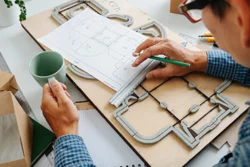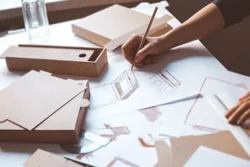Since September last year, the MC-Box has been produced in St. Ruprecht, at the Styrian site of Rondo Ganahl AG. Modular packaging is a revolutionary concept for heavy goods: it is the first wood-free alternative to classic transport boxes with numerous configuration options.
The MC-Box has long been manufactured at the company’s site in Langenenslingen, Germany, and now Rondo has added this packaging concept to its product range in Austria. It is designed as heavy-duty packaging and consists of corrugated cardboard and honeycomb panels that are glued and wet-strengthened in a unique process (“multicross”). Very high stability is achieved due to the counter-rotating corrugation directions. Plug-in modules made of metal or plastic form solid corner joints. The MC-Box is suitable for almost any heavy goods to be transported. Depending on the requirements, it stands on a load carrier made of OSB boards with skids, INKA presswood pallets, or wooden pallets. In addition, the MC-Box can be customized in terms of formats, printing, and interior and is manufactured from as little as one piece.
We can respond individually to customer requirements with the MC-Box. The box's panel size is variable and can be produced up to a maximum of 2.2 x 6 meters. Statically it is loadable up to 5 tons; dynamically, it is 2 to 3 tons. The substructure can be selected according to the respective requirements. The interior can be designed freely according to the customer's wishes, for example, with compartments for storage or inserts according to the respective goods' transport requirements. Here we work closely with the customers. Our development department makes 3D designs, produces samples into which the product is fitted. And we are also extremely flexible when it comes to customer requirements for the exterior design: we can print the MC-Box on all sides using the digital printing process.
Ernst Kogler, Key Account and Category Manager at Rondo
Especially for export markets, the MC-Box as non-wood packaging brings some advantages compared to the classic wooden transport boxes. In contrast to wooden packaging, there are no restrictions on deliveries to the EU, Canada, the USA, Mexico, and the Asian region. Their low dead weight saves costs because compared to wood, the cardboard layer boards achieve weight savings of up to 40 percent. And thanks to the modular plug-in design, the box can be used several times; missing or damaged modules can be easily replaced.
Aicomp maps the MC-Box in SAP
Rondo commissioned Aicomp to create and implement a suitable configuration model for their SAP system. Since Rondo already uses Aicomp’s variant configurator VCPowerPack, the focus was on a very detailed mapping of all production-relevant material and labor in SAP ERP, as is usually the case with VCPowerPack customers.
Rondo customers should benefit from a fast, error-free, and accurate quote calculation that reflects the detailed design options of the MC-Box.
The mapping of MC-Box production in SAP was initiated for production at the St. Ruprecht site. The knowledge was gained through an on-site visit to the company’s German location in Langenenslingen, where the MC-Box production has long been in effect.
The diversity of variants of the MC-Box
The MC-Box can be individually designed in terms of formats, printing, and interior so that all possibilities are available.
The outer construction consists mainly of corrugated board and honeycomb panels and the corner joints. Variations in the design arise via the paper quality or grades, different production dimensions, possible printing, and optional labels. If required, an additional laminated film (MC-Resist) can be used for moisture-sensitive boxes. The corner joints (MC-Fix modules) are made of plastic or metal.
Pallets, chipboard, INKA presswood pallets, and MC or plastic feet are available for the substructure, which are mapped in the respective number to match the box configuration.
The interior fittings of the MC-Boxes are essential. WP or MC compartments, foams, VCI (Volatile Corrosion Inhibitor) bags, and individually plotted unique interiors are possible for this.
Map production factors in the system
Several operations are necessary for the production of an MC-Box, which must also be recorded in detail in the system to enable valid costing.
The MC-Box needs a flexible system for configuration. The box itself already offers numerous factors that are mapped by the system. However, our aim is to map as many relevant resource and cost centers as possible that can arise during production. This starts with the various versions of procurement, through different machine routings, to delivery options at the end customer. Ultimately, this means that each of our customers has an individual configuration setup that enables them to create the most precise product configurations and calculations as early as the customer inquiry stage.
Jörg Helmreich, Partner and General Manager at Aicomp Germany
At Rondo, procurement for MC-Box production differs between raw materials from the company’s own corrugated board production and the purchase of additional parts, such as the MC-Fix modules, pallets, or even plastic materials for the interior fittings. In addition, purchases can be included in the calculation in case of own production bottlenecks.
In the laminating process, the honeycombs are pushed through a gluing machine and then pressed together between two- or three-flute corrugated board sheets in a press. The corresponding working and drying times are recorded in the system.
During the cutting process, the finished MC material still has to be cut according to the order. Rondo offers sawing or cutting machines for this purpose. The individual performance and tolerance parameters of the machines and the respective waste are taken into account in the configuration model. Cutting and sawing waste can subsequently be used for further use of, e.g., MC feet.
For the substructure production, the work efforts and optimization specifications of the sawing machine and the necessary steps in manual work are recorded.
There are two basic options to consider when assembling: the MC-Box can be supplied assembled or disassembled as a kit. The assembly is shown as a manual process. A catalog of different activities is created, each with a time value depending on complexity and area/size. The total time required to erect an MC-Box is then calculated from the sum of the individual activities.
If the box is delivered disassembled, the materials are folded to save space. Palletizing is optional; various packaging materials are included in the calculation.



